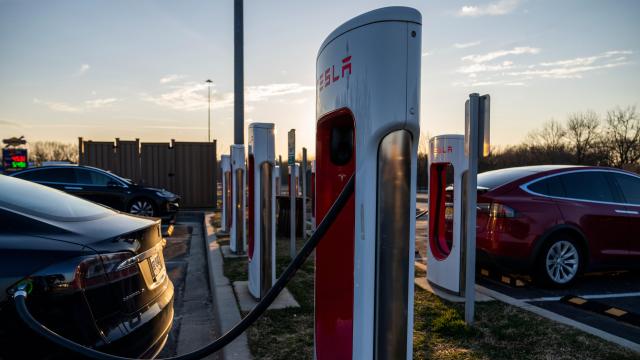If you’re tired of skyrocketing gas prices and are thinking about the benefits of an electric ride, chances are you’re not alone. But even though switching to an electric vehicle may seem like a no-brainer, there are some significant obstacles — including new problems caused by the conflict in Ukraine — facing the EV industry right now, which means that demand is likely to outstrip supply for the time being.
Even before high prices at the pump, the worldwide transition to electric vehicles was switching into high gear. Sales of EVs doubled across the world in 2021 compared to 2020. Several huge automakers, like GM, have made big investments in EV models and factories, while others, like Volvo, have promised to totally stop producing gas-powered cars over the next decade. In February, the Department of Energy unveiled a $US5 ($7) billion plan to create a nationwide EV charging network. Cities across the U.S., from Charleston, West Virginia to Saginaw, Michigan, are making moves to install electric charging stations.
Gas prices were already high (for a variety of reasons, none of them related to the Biden administration’s environmental policies) before Russia’s invasion of Ukraine. Those steeper prices are going to last a while.
“The cost of fuelling a gas car is almost always more expensive than an EV car,” Nick Nigro, the founder of Atlas Public Policy, a firm that provides analytical tools on transportation and building electrification, told Earther. “For consumers, electricity prices are mostly stable over decades, because they’re regulated in the U.S. They’re not free to float with the demands of a commodity like oil.”
It’s difficult to gauge whether immediate demand for EVs is up as a result of the increased gas prices over the past month. (Some initial numbers suggest that may be the case: 25% of consumers on Edmunds.com, a car-shopping site, looked at EV options in the second week of March, an 84% increase from the same week in February.)
“What we can say with certainty is that EVs mostly are selling as fast as automakers can make them,” Nigro said. “The signals from the market to the consumer, from high gas prices to volatility in the oil market, are only going to accelerate the interest in [the EV] transition. We know from research that consumers do respond to these price shocks and purchase traditionally more fuel-efficient vehicles — with electric vehicles available, they are the most efficient vehicles a consumer could buy. It stands to reason that the demand for EVs could grow because of that.”
But electric cars could be hard to find in the short term. Like basically anything moderately expensive and complicated to make that you might want to buy these days, from furniture to electronics, EVs are suffering the same general supply chain and labour shortages affecting so many industries.
“Because of supply chain issues across the auto industry, it’s hard to really gauge how strong EV demand is relative to conventional vehicle demand, because demand for both types of vehicles is constrained by supply right now,” Nigro said. “It’s very hard for the industry to turn on a dime.”
There’s another big EV-specific roadblock that could be made even more complicated by the conflict in Ukraine: the precious metals and other raw materials that go into batteries. Elements like lithium, cobalt, and nickel are all key to producing the technology that makes electric vehicles go. These were already facing big supply crunches before, thanks to the clean energy revolution: Demand for lithium alone is projected to grow 70 times by 2040. Both Russia and Ukraine are important suppliers or dealers of many of these elements. While Russia’s actual nickel deposits are small, one of the world’s largest producers of nickel is a Russian company, which has not yet faced sanctions. Still, the idea of this company being cut off from the global market was enough to send buyers into a frenzy, and global nickel prices doubled in one day earlier this month. Just before the war, Ukraine began holding auctions to develop its reserves of lithium, cobalt, copper, and nickel.
“Raw materials are going to be an issue for years to come,” Markus Duesmann, CEO of Audi, told the New York Times.
The Biden administration has made fast-tracking the development of domestic production of these materials a priority, and Biden is reportedly drafting an executive order toward that goal. Automakers and experts say that the escalating tensions in Ukraine could accelerate the development of metals elsewhere as demand for electric cars increases. But since it takes time to develop new sources of these important commodities — which also have their own serious environmental and justice issues — the industry is looking at a long, possibly painful adjustment period.
Editor’s Note: Release dates within this article are based in the U.S., but will be updated with local Australian dates as soon as we know more.
